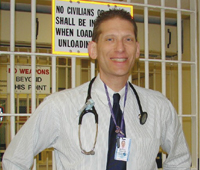|
|
 |
 |
|
ALUMNI UPDATESDr. Budd Heyman ’81 Serves Rikers Island InmatesBy Alia Malek ’06J 

Dr. Budd Heyman ’81, in front of the gates to Ward 19-S at Bellevue Hospital, where he provides medical care to prisoners. PHOTO: COURTESY Dr. BUDD HEYMAN ’81 
Dr. Budd Heyman ’81 has spent most of the last 14 years behind bars — by choice. On each weekday and most holidays since 1993, he has been a friend to the friendless, ministering medicine to prisoners from Rikers Island at Bellevue Hospital’s ward 19-S, where he is director of prison health services. The Spartan ward, known as 19-South, is the place where prisoners are treated. Its walls are white, its windows covered with floor-to-ceiling bars. Just getting to the ward requires passage through a synchronized series of sliding gates, monitored by closed-circuit televisions and manned by New York City police. Heyman’s prisoner-patients often suffer from HIV-related illnesses, pneumonia, drug/alcohol addictions and broken jaws — the afflictions of the incarcerated and of the POWs in the War on Drugs. Some patients require specialized care on other floors. In that case, their legs are shackled (unless Heyman says their condition precludes it) and an armed police officer stands outside their door. When his patients are transferred to these other floors, Heyman follows, which has made him well-known to staff all over the behemoth hospital. As he moves through its corridors, he’s often hailed with a “Hey, Dr. Heyman” from a disembodied voice passing by in the kinetic rivers of people making their way. But Heyman is hard to miss anywhere. At 6-foot-7, he towers, and his voice is buoyed by his Brooklyn-accented loquaciousness and constant affability. He maintains the same manner with everyone on 19-S, including the prisoners, and his gregariousness creates a feeling of normalcy in the abnormal, a sense of equality in a situation inherently unequal. “Even though the patients are prisoners, he treats them like patients first,” says Donald Bolding, a clerical associate on 19-S. “He has a bedside manner that most doctors don’t have with regular patients.” Heyman’s equal opportunity behavior comes from his belief that no one deserves substandard medical care. He also believes that everyone should be able to die as dignified a death as possible. This conviction has driven Heyman to brave the daunting labyrinth of city bureaucracies, including the public defender’s office, the prosecutor’s office, the courts and the parole board. He believes in advocating for the “compassionate release” of critically or terminally ill prisoners so they can live their remaining days (and sentence) outside of prison. If released, prisoners might go to their families or to a civilian bed at Bellevue. The procedure requires that Heyman put his reputation on the line by stating that a prisoner is terminally ill or of such limited functional capacity he is not likely to commit another crime. He also has to make his case to everyone involved, from the D.A. to the judge to the parole board to the defense attorney. But “it’s the right thing to do,” Heyman says. “It’s part of being compassionate, and part of being a physician.” As of April, he had secured compassionate release for 393 prisoners. While those who knew Heyman at the College might be surprised to hear where he works, Heyman thinks it will not be a shock to them that he became a doctor and works with an underserved population. “It’s what I always said I would do,” he says. From his earliest days in Homecrest in Brooklyn, Heyman knew he wanted to go to Columbia. As an aspiring basketball player, he was a fan of the school’s team. While still in high school, Heyman approached a v.p. at B. Altman & Co., the department store where he worked part-time, and shared his dream. The v.p. referred him to another v.p., Taylor Affelder ’27, and Heyman made his pitch for Columbia, mentioning his basketball skills. Affelder listened, then set up an interview. Heyman picked out an outfit he thought “appropriately preppy” (a checkered brown and white blazer with a creamy yellow vest), and was accepted a few weeks later. “Going to Columbia was a dream come true for me,” he says. Heyman majored in pre-medicine, concentrating in history, then went to medical school at SUNY-Downstate, graduating in 1986. He did his residency at Beth Israel and took his first job in 1989 as medical director of St. Vincent’s Prison Health Service, treating detainees at the Manhattan Detention Complex and the two prison boats then anchored off Lower Manhattan. Heyman loved the job from day one. Having to adjust quickly from being a medical resident to a director with administrative duties that included overseeing 200 full- and part-time employees meant Heyman was on a steep learning curve, but with the support of a dedicated staff, he says, “We were able to make a difference every time.” Heyman goes back to campus every once in a while. Occasionally, he even studies (for board reviews) in Butler Library, sitting at the same table where he used to simultaneously study and goof off with Rick Rutecki ’81E and Danny DiPaola ’79 GS. Heyman remembers the stress of the pre-med curriculum but only with appreciation: “Columbia made me a better person and has enabled me to help better the lives of others.” Alia Malek ’06J lives in New York City. This is her first article for CCT.
|
|
||||||||||||||||||||||||||||